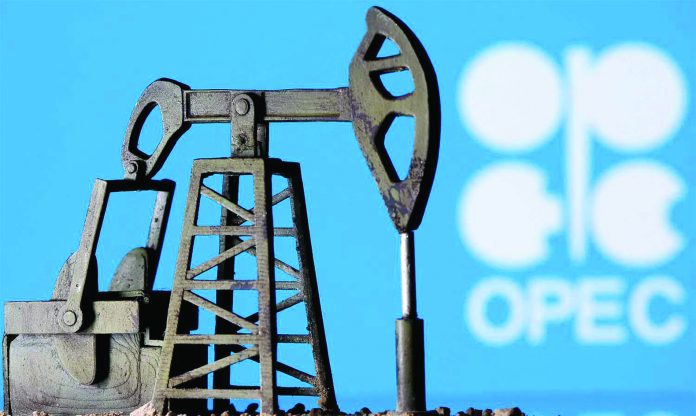OPEC projects world oil demand to hit 103 m. bpd in ’23
VIENNA: The Organization of the Petroleum Exporting Countries (OPEC) projected the growth of world oil demand at 2.7 million barrels per day (bpd) to average 103.0 million bpd in 2023 driven by growth in major importing countries, notably the United States.

Despite different opinions on how to manage fallout from the crisis, OPEC+ has been able to unite around a very cautious policy of slow increase in capacity based on "Saudi prudence"
It its Monthly Oil Market Report (July, 2022) released on Tuesday, the Organization said the crude oil spot prices rose in June, extending the previous month’s increase.
Higher futures prices and strong physical crude market fundamentals drove the increase, amid higher crude demand from refiners and several supply disruptions. The OPEC Reference Basket rose USD 3.85, or 3.4 percent, to settle at USD 117.72/b. The ICE (Intercontinental Exchange) Brent front month increased by USD 5.54, or 4.9 percent, in June to average USD 117.50/b and NYMEX WTI (New York Mercantile Exchange – West Texas Intermediate) rose by USD 5.08, or 4.6 percent, to average USD 114.34/b.
The Brent/WTI futures spread widened by 46 cents to an average of USD 3.16/b. The market structure of all three major crude benchmarks – ICE Brent, NYMEX WTI and DME (Dubai Mercantile Exchange) Oman – strengthened further in June and prompt time spreads moved into deeper backwardation.
Hedge funds and other money managers cut net long positions by nearly 11 percent in the two major futures contracts. World Economy World economic growth in 2022 remains broadly unchanged at 3.5 percent, while the initial forecast for 2023 expects global growth of 3.2 percent.
US GDP growth for 2022 remains unchanged at 3.0 percent, followed by 2.1 percent growth in 2023. Euro-zone economic growth for 2022 is unchanged at 3.0 percent, while growth in 2023 is forecast at two percent. Japan is expected to growth by 1.7 percent in 2023, following growth of 1.6 percent in 2022, unchanged from the previous report. China’s 2022 growth remains at 5.1 percent and GDP growth in 2023 is seen slightly lower at five percent. India’s GDP growth remains at 7.1 percent in 2022 and is expected to grow by six percent in 2023. Brazil’s economic growth forecast for 2022 remained unchanged at 1.2 percent, increasing to 1.5 percent in 2023.
For Russia, the 2022 GDP growth forecast is unchanged, showing a contraction of six percent, while growth is anticipated to recover to 1.2 percent in 2023.
Consumption remains robust, especially in the advanced economies, with an expected continued recovery particularly in the contact-intensive services sector, which includes travel and transportation activity, leisure and hospitality.
However, significant downside risks exist, stemming from ongoing geopolitical tensions, the continued pandemic, rising inflation, aggravated supply chain issues, high sovereign debt levels in many regions, and expected monetary tightening by central banks in the US, the UK, Japan and the Euro-zone. World Oil Demand World oil demand growth in 2022 remains unchanged from the previous month’s assessment at 3.4 million bpd.
Oil demand in the OECD is estimated to increase by 1.8 million bpd, while non-OECD is seen growing by 1.6 million bpd.
Total oil demand is projected to average 100.3 million bpd. The first quarter of this year was revised higher, amid better-than-anticipated oil demand in the main OECD consuming countries. However, with the resurgence of COVID-19 in China and ongoing geopolitical uncertainties, oil demand in 2Q-22 is revised lower.
For 2023, world oil demand growth is expected to reach 2.7 million bpd to average 103.0 million bpd, with the OECD (Organisation for Economic Co-operation and Development) growing by 0.6 million bpd and non-OECD growth forecast at 2.1 million bpd.
Oil demand in 2023 is expected to be supported by a still solid economic performance in major consuming countries, as well as improved geopolitical developments and containment of COVID-19 in China, according to the report.
World Oil Supply Non-OPEC liquids supply growth in 2022 remains broadly unchanged from the previous month’s assessment, despite upward revisions to China and Canada, and is now expected to grow by 2.1 million bpd to average 65.7 million bpd. The main drivers of liquids supply growth for the year are expected to be the US, Canada, Brazil, China, Kazakhstan and Guyana, while production is expected to decline mainly in Russia, Indonesia and Thailand. In 2023, non-OPEC liquids production is projected to grow by 1.7 million bpd to average 67.4 million bpd.
Liquids supply in the OECD is forecast to increase by 1.4 million bpd in 2023, while non-OECD is seen growing by 0.2 million bpd.
The main drivers for 2023 are expected to be the US, with growth of 1.1 million bpd, followed by Norway, Brazil, Canada and Guyana. However, uncertainty regarding the operational aspects of US production and from ongoing geopolitical developments remains high. OPEC NGLs (natural gas liquids) and non-conventional liquids are forecast to grow by 0.1 million bpd in 2022 to average 5.39 million bpd and by 50 tb/d to average 5.44 million bpd in 2023.
OPEC-13 crude oil production in June increased by 234 tb/d m-o-m to average 28.72 million bpd, according to available secondary sources.
Demand for OPEC crude in 2022 remains unchanged from the previous month’s assessment to stand at 29.2 million bpd, which is around 1.1 million bpd higher than in 2021. Based on the initial forecasts for world oil demand and non-OPEC supply in 2023, demand for OPEC crude is expected to reach 30.1 million bpd, 0.9 million bpd higher than the 2022 level, the report added.











